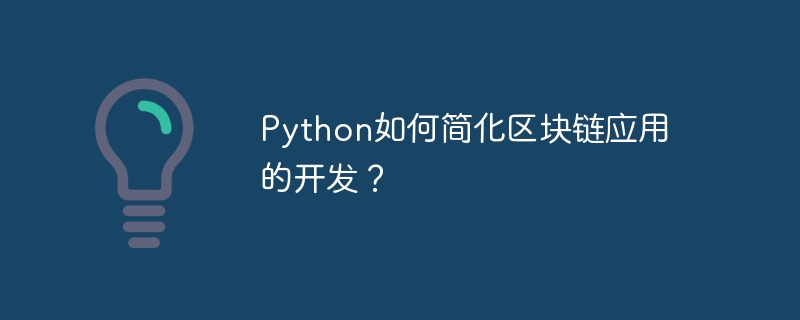Home >Backend Development >Python Tutorial >How does Python simplify the development of blockchain applications?
How does Python simplify the development of blockchain applications?
- WBOYWBOYWBOYWBOYWBOYWBOYWBOYWBOYWBOYWBOYWBOYWBOYWBforward
- 2024-03-16 22:10:11931browse

1. Simplified contract development
python Provides contract development frameworks , such as WEB3.py and Truffle, allowing developers to easily create and deploy Smart contracts. These frameworks allow users to focus on contract logic by abstracting the underlying complexity. Python’s concise syntax and readability also make it easier to write and maintain smart contracts.
2. Rich library
The Python ecosystem has a rich library that can be used for all aspects of blockchain development. For example, the Pythereum and Ethereum-rpc libraries provide interaction with Ethereum nodes, while Web3.py provides a common interface to the Ethereum blockchain that can speed up the development process.
3. Advanced data structure
Python's advanced data structures , such as lists, dictionaries, and sets, can easily represent distributed ledger data. This simplifies data processing and manipulation, allowing developers to focus on core business logic.
4. Scalability
Python’s modular design makes it easy to integrate with other languages and frameworks. This allows developers to take advantage of other ecosystems when necessary, thereby enhancing the scalability and flexibility of their applications.
5. Community support
Python has a large and active community that provides extensive support to blockchain developers. Online forums, documentation, and tutorials provide valuable resources to help developers solve problems and advance projects.
Specific example:
- Smart Contract Development: Web3.py allows developers to easily create and deploy smart contracts using Python.
- Blockchain Data Analysis: Python libraries such as pandas and NumPy can be used to analyze blockchain data and extract insights.
- Decentralized Applications (dApps): Python frameworks such as Django and flask can be used to build interactive dApps to interact with the blockchain.
in conclusion:
Python provides a strong foundation for the development of blockchain applications through simplified contract development, rich libraries, advanced data structures, scalability, and community support. It enables developers to quickly and easily create complex and robust blockchain applications, accelerating innovation and adoption in the field.
The above is the detailed content of How does Python simplify the development of blockchain applications?. For more information, please follow other related articles on the PHP Chinese website!
Related articles
See more- Looking at the initial chain from the development process of blockchain
- How to implement blockchain development in PHP?
- The future of blockchain development - analysis of the advantages of Go language system
- The Phantom Beast Palu is a hit on Steam! Ethereum and Solana's meme coins PALW and PAL are launched
- After the Cancun upgrade, will the gas fee of Ethereum L2 really be reduced by more than 90%?

